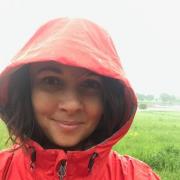Nature
Berry song
Michaela Goade
RECEIVED
Picture Books, Read Woke, Nature, Poetry
As a young Tlingit girl collects wild berries over the seasons, she sings with her Grandmother as she learns to speak to the land and listen when the land speaks back.
Mushroom rain
Laura K. Zimmermann
j579.6 Zimmermann
Picture Books, Nonfiction, Nature
"Through lyrical text and colorful detailed artwork, the mysterious and sometimes bizarre world of mushrooms is explored. Back matter includes a glossary and science facts"--
Budding mycologists and those less passionate about fungi will equally enjoy this beautifully illustrated nonfiction title. -Casey
Kitty
Rebecca Jordan-Glum
jE Jordan-Glum
Picture Books, Humor, Nature
"Granny thinks catsitting will be easy. She'll make her signature cupcakes, give the cat a good brushing, and together they'll share a sweet night's rest. But Kitty has other plans. After Granny loses her glasses and accidentally lets a raccoon inside, all bets are off--much to the cat's displeasure"--Inside jacket flap
Funny and adorable! Sure to be a read-aloud hit! -Casey
Into the forest : the secret language of trees
Susan Tyler Hitchcock
582.16 /Hitchcock
Nonfiction, Nature, Science
"For millennia, trees have offered renewal and inspiration. They have provided for humanity on every level, from spiritual sanctuary to the raw material for our homes, books, and food. In this beautiful and revealing book, National Geographic combines legendary photography with cutting-edge science to illuminate exactly how trees influence the life of planet Earth--from our personal lives to the weather cycle. Beautifully illustrated essays tell the stories of the world's most remarkable trees, from Tane Mahura in New Zealand, the ancient Maori "lord of the forest," to Pando, a single aspen spreading over 100 acres: Earth's largest living thing. You'll also discover how an astronaut carried tree seeds to the moon and back; the reason "microdosing" on tree gas is a sure way to boost your immune system; and why playing in the dirt boosts serotonin, happiness hormone"--Amazon.
This is another book I discovered because I got to catalog it. Perks of the job! It's beautiful. Simply lovely pictures of different species of trees with a short history or factoid of each one. My. Jam. -Melody
Fairy houses : how to create whimsical homes for fairy folk
Sally J. Smith
635.967 /Smith
Nature, Nonfiction, Crafts, Gardening
Create the ultimate fairy houses, made with natural materials - just the way real fairies build their homes! Have you ever seen a real fairy house? Not the ceramic ones you purchase, but a real fairy house made from natural elements? Well, now you can build your own miniature magical abode - the perfect addition to your garden. Revealed in Fairy Houses for the first time are the step-by-step instructions for constructing exquisite fairy houses, explained by master fairy house architect Sally Smith. From her home on the edge of the Adirondacks, Smith has been creating one-of-a-kind fairy residencies for years. She uses natural artifacts such as butterfly wings for stained-glass windows, twigs for window frames, and birch bark for walls. Smith reveals her building secrets in Fairy Houses. Readers begin their fairy house project by flipping through an inspiration gallery, deciding what kind of house they wish to create and considering where in nature they'll put it. From there, readers learn about building materials (found and natural), on-site fairy house construction, how to light a fairy house, and how to incorporate stonework into the design. All of Smith's secret tips and techniques are then showcased in a series of step-by-step photos, making fairy house creation easy. The ones featured in Fairy Houses were designed especially for this book and are meant for longer-lasting installations. With this book, fairy houses move beyond "cute" and into beautiful nature-woven works of art. When you're through, you'll find yourself in an enchanted land where a Lord of the Rings-esque mood is magically evoked.
This beautiful book is just the whimsy I need on this rainy day! It's a nice hardcover loaded with colorful photos and helpful instructions. I have ZERO crafty skillz, but that doesn't stop me from looking at this cute mini houses made from bark, sticks, and leaves that you can stumble upon in your backyard. -Melody
The crab ballet
Renée LaTulippe
jE LaTulippe
Picture Books, Nature, Music
When the tide is out, the Crab Ballet begins, featuring anemones, squid, crabs and many other sea creatures, an aquatic corps de ballet performing for the reader.
Beautiful, entertaining, and educational! -Casey
A perfect day
Jennifer Yerkes
jE Yerkes
Picture Books, Nature
"One bright summer day, the animals of the pond create a symphony of sounds"--
Beautiful illustrations, minimalistic text, and ample space for performative storytelling make for a fabulous storytime read-aloud. Just right for sharing and beginning readers! -Casey
The snail with the right heart : a true story
Maria Popova
This is the real-life story of Jeremy, a rare garden snail found in 2015 by a retired London scientist. Jeremy's shell spiraled to the left, indicating reversed internal anatomy--including a heart positioned on the right. As a result, a similarly rare mate was needed in order to procreate.
I've been waiting for the prolific blogger of Brain Pickings, Maria Popova to finally write a book and it's as delightful, observant, dry and fascinating as she is. This is a children's book but should be enjoyed by all ages. If you like this, check out You are Stardust by Elin Kelsey (a book Popova once recommended on her blog!). -Victoria
A walk in the woods : rediscovering America on the Appalachian Trail
Bill Bryson
917.4 /Bryson
Nonfiction, Nature
The Appalachian Trail stretches from Georgia to Maine and covers some of the most breathtaking terrain in America—majestic mountains, silent forests, sparking lakes. If you’re going to take a hike, it’s probably the place to go. And Bill Bryson is surely the most entertaining guide you’ll find. He introduces us to the history and ecology of the trail and to some of the other hardy (or just foolhardy) folks he meets along the way—and a couple of bears. Already a classic, A Walk in the Woods will make you long for the great outdoors (or at least a comfortable chair to sit and read in)
Added by Beth
This is your mind on plants
Michael Pollan
Of all the things humans rely on plants for-- sustenance, beauty, fragrance, flavor, fiber-- surely the most curious is our use of them is to change consciousness: to stimulate or calm, fiddle with or completely alter, the qualities of our mental experience. Pollan dives deep into three plant drugs-- opium, caffeine, and mescaline-- and explores the cultures that have grown up around these drugs. He examines the powerful human attraction to psychoactive plants, and the equally powerful taboos with which we surround them. The result is a unique blend of history, science, memoir-- and participatory journalism. -- adapted from jacket
Absolutely fascinating read on the relationships and complications of how humans have defined, legitimized, legalized or criminalized our interactions with plants. For centuries we have relied on plants for, among other things their sustenance and nourishment. We've used them ceremoniously and of course for their mind-altering properties. In this book Pollan highlights the narrow lens and dogma of "The War on Drugs," and instead presents a more open discussion of the layered properties of plants (opium, caffeine, and mescaline) and their potential. -Victoria





Lyrical and visually stunning, Berry Song is a picture book for all seasons. -Casey